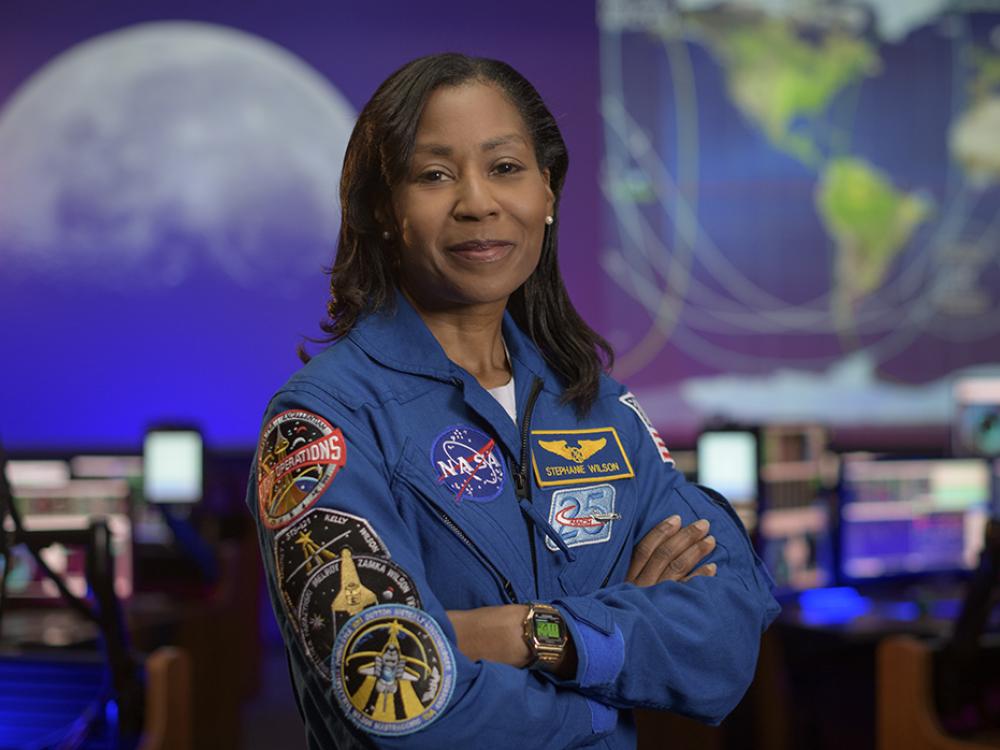
Stephanie D. Wilson: On Her Way to the Moon?
Feb 23, 2022
By Valerie Neal

Feb 23, 2022
By Valerie Neal
NASA has announced its intent to send the first woman and the first person of color to the Moon during the Artemis program. That may happen on the Artemis II or Artemis III mission within the next few years, if the uncrewed Artemis I flight occurs in 2022 as currently planned.
One likely candidate is Stephanie Diana Wilson, NASA’s most senior, most flown-in-space African American female astronaut. Selected to become an astronaut in 1996, she became the second Black woman in space, flying on three Space Shuttle missions to the International Space Station (ISS) and logging 42 days in orbit. Wilson is now one of 18 members of the Artemis astronaut team, a group of nine men and nine women from diverse backgrounds. She has been an astronaut longer than anyone else on the team and has flown more times than all but one of them. Her odds of earning a spot on a four-person Artemis crew seem good.
A native of Massachusetts, Wilson was born in 1966 and became interested in astronomy and engineering as a teenager. She earned a bachelor’s degree in engineering science at Harvard University and a master’s degree in aerospace engineering at the University of Texas. Her first engineering jobs were with Martin Marietta Astronautics and NASA’s Jet Propulsion Laboratory.
Stephanie Wilson earned a degree in engineering science at Harvard University and another in aerospace engineering at the University of Texas. Working at NASA’s Jet Propulsion Laboratory was one of her first jobs. (Image courtesy of NASA)
Wilson then launched her career as a NASA astronaut. Since becoming a Mission Specialist astronaut candidate at age 29 upon her second application, she has worked on various space station and robotics projects, served on the CAPCOM (Capsule Communicator) team and the Astronaut Selection Board, and held management positions. Wilson was a principal robotic arm operator on three shuttle missions: STS-121, STS-120, and STS-131. In that role, she handled inspections of the spacecraft exterior for damage, maneuvered modules and equipment between the space shuttle and the ISS, and supported spacewalks. She also served as flight engineer assisting the pilots during launch and entry, and as loadmaster, coordinating the transfer of tons of supplies and equipment between the shuttle and station.
Among her unusual distinctions, Wilson flew all three of her missions on the orbiter Discovery—now displayed at the Steven F. Udvar-Hazy Center—the only astronaut with that record. She was a crewmember in 2007, the only time two women commanded space missions simultaneously, and she was on board the only time there were four women on the ISS, in 2010. Wilson also was the lead CAPCOM during the ill-fated last Columbia mission (STS-107) and again for the first all-woman spacewalk in 2019. She has received NASA’s Distinguished Service Award twice and has been awarded three honorary doctorates, plus many other accolades.
Stephanie Wilson was a crewmember during the only time two women (Pamela Melroy and Peggy Whitson) commanded space missions simultaneously. (Image courtesy of NASA)
These four women (Stephanie Wilson, Tracy Caldwell Dyson, Naoko Yamazaki, and Dorothy Metcalf-Lindenburger) made history when they were on the International Space Station together. (NASA)
When asked about the challenges of being an astronaut, Wilson says that learning to swim was the hardest, and the most unrelenting one is making sure she does her part to ensure mission success. Her long experience and commitment to spaceflight may well earn Wilson a historic opportunity on an Artemis mission to the Moon. Stay tuned!
Stephanie Wilson’s mission patches telegraph her experience as one of NASA’s most senior astronauts. (Image courtesy of NASA)
Valerie Neal, Ph.D., Curator Emerita, Space History Department.
We rely on the generous support of donors, sponsors, members, and other benefactors to share the history and impact of aviation and spaceflight, educate the public, and inspire future generations. With your help, we can continue to preserve and safeguard the world’s most comprehensive collection of artifacts representing the great achievements of flight and space exploration.